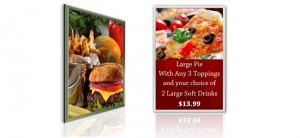Display Fixtures
Counter Displays- When you have run out of window and wall space for your marketing pieces, counter displays are often used right around the point of sale. These displays are typically pretty small and are often used for daily specials, flavors, etc.
Easels- Think of an artist and the canvas that they paint on. What holds that canvas is called an easel. In the restaurant industry, easels are used for a variety of reasons but are usually placed just outside the front door of the restaurant or in the waiting area.
Stand-offs- These are accessory pieces to wall mounted pictures, frames, graphics, etc. The two most common reasons for the use of stand-offs are (1) when you want to add some depth to your picture; or (2) when your wall isn’t entirely flush and you want your graphic to straddle a molding (for instance).
Dimensional Signs- Signs that can have multiple layers and colors depending on your needs. They are ideal for more contemporary fast casual locations and look great over the counter (logo), as way finders (bathrooms) and on walls (decorative food images).
Light Boxes
Fluorescent Light Boxes- These signs are illuminated by standard fluorescent lamps that are easily replaceable. Usually, T8 or T12 fluorescent bulbs are used depending on size. Unlike the thin profile of LED light boxes, these tend to near 3” at their thinnest.
Hidden-Hinge- A part of a light box cabinet where there is a door that swings open. The hinge is concealed so there is no visible hardware when the door is closed.
Internal Power Supply- This is a light box where the power supply is concealed inside so you don’t have to hide or cover it. Since the power supply is hidden, it provides a clean finish to the light box.
LED Light Boxes- LED refers to the energy efficient lighting source that illuminates the light box. This type of lighting can yield savings up to 90% and have an expected lifetime of 50,000-100,000+ hours.
Side loading / Front loading / Top loading- This refers to the options you have when loading your graphics. You have to be mindful of where the light boxes are going to be before selecting which way you would like. If the light box is placed close to the ceiling, the top load will not work, and if beside another light box, the side load won’t work.
Snap-frames- Commonly seen on LED light boxes, these frame accommodate both poster and paper prints under a protective clear or matte lens. All sides snap open for easy change-out of graphics.
Banners
Fabric- Colors turn out exceptionally vibrant on fabrics for an eye-popping display. Banners and backdrops are among the products that are made with this material.
Grommets- The metal holes that are often placed in the corner of a banner. Depending on the size, there may be more of these throughout the edges of the banner. Rope, bungee cords, cables, etc. are often run through these to hang the banner in place.
Mesh- There are crisscrossed fibers which create a printable surface. Much like mesh fabric, you can see through this material to some extent but still also see the printed graphic. This material is commonly used for outdoor banners along fences and in between poles.
Scrim Vinyl- The most common material, it is made of a strong nylon mesh covered in vinyl. This material offers durability. This vinyl has a 3-5 year life span when continuously used outdoors, and a 7-10 year life span when continuously used indoors.
Graphics
Glossy- This is a type of finish that looks reflective and shiny. Graphics destined to have lights or sunshine on them would not be ideal for a glossy finish.
Magnetic- A printed graphic that is mounted to a magnetic sheet, offering you the flexibility to swap out full graphics or strips and digits on the fly.
Matte- This is a type of coated finish that appears dull. Colors often appear softer on a matte finish. Text can be easier to read on matte finished papers than on glossier finishes.
Mounted- This refers to the act of placing a graphic on to any type of substrate. For example, sintra, corrugated plastic, foam core or gator board. Mounting a graphic provides greater durability and depth to the otherwise 2D graphic.
Are there some terms in one of the categories above that we didn’t mention that leave you scratching your head? If so, let us know and we’ll de-code them for you. Email us at info@origindisplays.com or give us a call today at 888-235-2579 and let us know!
